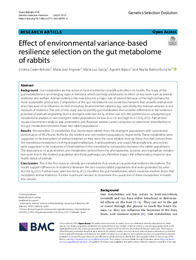Título :
Effect of environmental variance-based resilience selection on the gut metabolome of rabbits |
Autor :
Casto-Rebollo, Cristina 
Argente, María José 
Garcia Pardo, Maria Luz 
BLASCO, AGUSTIN 
Ibanez-Escriche, Noelia  |
Editor :
BMC |
Departamento:
Departamentos de la UMH::Tecnología Agroalimentaria |
Fecha de publicación:
2023-03-09 |
URI :
https://hdl.handle.net/11000/30869 |
Resumen :
Background Gut metabolites are key actors in host-microbiota crosstalk with efect on health. The study of the gut metabolome is an emerging topic in livestock, which can help understand its efect on key traits such as animal resilience and welfare. Animal resilience has now become a major trait of interest because of the high demand for more sustainable production. Composition of the gut microbiome can reveal mechanisms that underlie animal resil ience because of its infuence on host immunity. Environmental variance (VE), specifcally the residual variance, is one measure of resilience. The aim of this study was to identify gut metabolites that underlie diferences in the resilience potential of animals originating from a divergent selection for VE of litter size (LS). We performed an untargeted gut metabolome analysis in two divergent rabbit populations for low (n=13) and high (n=13) VE of LS. Partial least square-discriminant analysis was undertaken, and Bayesian statistics were computed to determine dissimilarities in the gut metabolites between these two rabbit populations. Results We identifed 15 metabolites that discriminate rabbits from the divergent populations with a prediction performance of 99.2% and 90.4% for the resilient and non-resilient populations, respectively. These metabolites were suggested to be biomarkers of animal resilience as they were the most reliable. Among these, fve that derived from the microbiota metabolism (3-(4-hydroxyphenyl)lactate, 5-aminovalerate, and equol, N6-acetyllysine, and serine), were suggested to be indicators of dissimilarities in the microbiome composition between the rabbit populations. The abundances of acylcarnitines and metabolites derived from the phenylalanine, tyrosine, and tryptophan metabo lism were low in the resilient population and these pathways can, therefore impact the infammatory response and health status of animals. Conclusions This is the frst study to identify gut metabolites that could act as potential resilience biomarkers. The results support diferences in resilience between the two studied rabbit populations that were generated by selec tion for VE of LS. Furthermore, selection for VE of LS modifed the gut metabolome, which could be another factor that modulates animal resilience. Further studies are needed to determine the causal role of these metabolites in health and disease
|
Palabras clave/Materias:
Animal resilience
Animal welfare
Metabolome
Rabbits |
Tipo de documento :
info:eu-repo/semantics/article |
Derechos de acceso:
info:eu-repo/semantics/openAccess
Attribution-NonCommercial-NoDerivatives 4.0 Internacional |
DOI :
https://doi.org/10.1186/s12711-023-00791-5 |
Aparece en las colecciones:
Artículos Tecnología Agroalimentaria
|
 La licencia se describe como: Atribución-NonComercial-NoDerivada 4.0 Internacional.
La licencia se describe como: Atribución-NonComercial-NoDerivada 4.0 Internacional.
.png)
